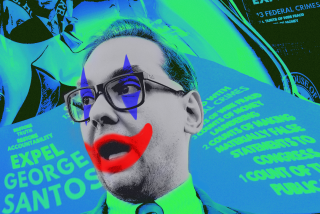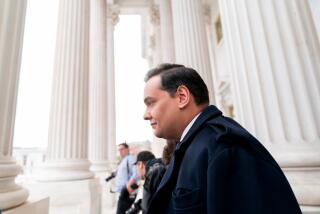Monica and the Death of Public Life
- Share via
AMAGANSETT, N.Y. — If ever one needed an event to mark the end of privacy in America, Wednesday’s interview with Monica S. Lewinsky would certainly qualify. For two hours, under the gentle prodding of Barbara Walters, young Lewinsky cheerfully bared everything, from her sexual proclivities to her battles with her weight, and revealed quite a few of President Bill Clinton’s secrets, for good measure. The only thing she left to the imagination was her feelings about independent counsel Kenneth W. Starr, and that only because she feared this Savonarola’s reprisal.
Of course, Lewinsky is no pioneer. She was only following a well-worn trail that Walters herself had helped blaze. For years, critics have complained that the steady incursion of the media into the private lives of public figures has eroded privacy until nothing is off-limits. We know celebrities’ addictions and abuses, their romances, finances, health, childhood transgressions, even their psychological needs. In truth, it seems there is little we don’t know.
But these critics may have it all wrong. It is not that there isn’t any privacy left. It is that there is nothing left of what used to be called the “public.” The constant revelation of the private has reduced the public and gradually usurped it until there is really no public life anymore: There is little serious public discourse, nothing that doesn’t concern private behavior. In fact, even conservatives, who once insisted on the primacy of privacy and saw intrusions into private life as unseemly, now insist on the continuity between what one does behind closed doors and what one does outside those doors. Or, put another way, when intimacies become the center of our public discourse, there is only confession and gossip.
What a sea change this is. It wasn’t so long ago that journalists and celebrities, be they politicians or entertainers, observed a strict demarcation between what was intended for public consumption and what was intended to be private. As Humphrey Bogart so pungently put it, all he owed his fans was a good performance. As late as the 1920s, no respectable U.S. newspaper would even publish birth notices, seeing them as an invasion of privacy, and gossip columnist Walter Winchell was reviled by many of his journalistic brethren for printing the sorts of things--divorces, affairs, pregnancies--that now win reporters accolades.
The Lewinsky interview was an object lesson in the end of the public, just as it was an object lesson in the flaunting of the private. There was scarcely a moment in the two-hour interview that was not dedicated to Lewinsky telling us some lurid detail or displaying some personal dysfunction as Walters sat there, with the rapt eagerness of a dog begging for table scraps. We learned about Lewinsky’s romantic travails, her lack of self-worth, her self-ascribed sensuality, her flirtations, her depressions. Lest all this seem stale, Walters promised a new “startling revelation,” which turned out to be that Lewinsky had had an affair with a Pentagon official, had gotten pregnant and then had an abortion. In short, Lewinsky had turned her deepest secrets into a tease for her interview and book.
She and Walters did the same thing for Clinton, making the private public and thus brutally shoving aside anything that did not concern the private. So we got a peek behind the public man: at his marriage, his broken pledge of fidelity, his talents as a lover. Clinton was treated as if he were just another of Walters’ movie-star subjects, for whom the actual work, the film, was much less exciting than the life. After all, who wants to talk public policy when you can talk phone sex?
But the death of the public was not only demonstrated by the content of Lewinsky’s interview. If anything, it was even more powerfully demonstrated by her attitude and that of Walters. Lewinsky seemed positively giddy playing the role of star, finally allowed to step out from behind the screen to show her fans her “true” self. Having assumed the celebrity persona, she engaged in self-analysis, rummaged her childhood for keys to her behavior, delivered the requisite secrets and even broke down on cue, turning every intimacy and emotion into public fodder. In point of fact, though, what this showed is that when it comes to her public life, Lewinsky doesn’t have one: All she’s got is her private life, publicly displayed.
Of course, Lewinsky is only a symptom. She realized that in a culture where celebrities are vying for attention, one of the best ways to get it--one of the only ways to get it--is by divulging all. Other celebrities sit for Walters or for Vanity Fair, knowing that the transaction is publicity for secrets, because they know few people really care about what little remains of the public: their work. In a sense, Walters is just a highfalutin version of Jerry Springer, the only real difference being that her guests have name recognition and his don’t. Other wise, she and Jerry and Oprah and Vanity Fair and People and “Hard Copy” are all in the same business: voyeurism.
It has come to that. An estimated 70 million viewers watched the Lewinsky interview and millions of others are rushing to buy her tell-all book, making us the first generation to know as much if not more about our president’s sexual habits than about his policies. Nearly 25 years ago, in his classic study, “The Fall of Public Man,” sociologist Richard Sennett, fearing the rise of personal confession and psychobabble, warned this might happen. Now, in a society that is all secrets all the time, we have fulfilled Sennett’s prophecy.


